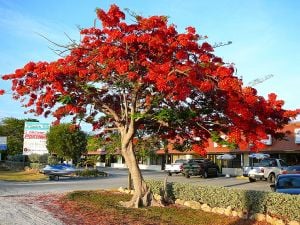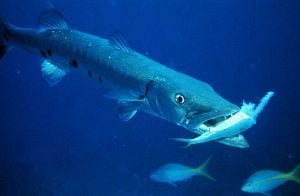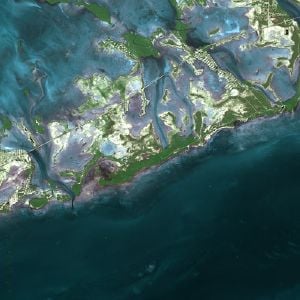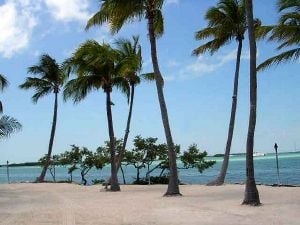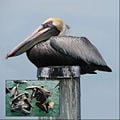Florida Keys

The Florida Keys are an archipelago of about 1,700 islands in the southeast United States. They begin at the southeastern tip of the Florida peninsula, about 15 miles (24 km) south of Miami, and extend in an arc southwest by south and then westward to Key West, the westernmost of the inhabited islands, and on to the uninhabited Dry Tortugas.
The islands, which stretch for a distance of 220 miles (355 km), lie along the Florida Straits, dividing the Atlantic Ocean to the east from the Gulf of Mexico to the west, and defining one edge of Florida Bay. At the nearest point, the southern tip of Key West is just 94 miles (151 km) from Cuba.
The total land area of the Keys is 137.3 square miles (356 km²). The 2000 United States census tabulated the population at 79,535, with an average density of 579.27 per square mile (223.66 /km²), although much of the population is concentrated in a few areas of much higher density, such as the city of Key West, which is home to 32 percent of the entire population of the Keys.
The natural habitats of the Keys are upland forests, inland wetlands and shoreline zones. Most of the Keys fall within the boundaries of national parks or other protected areas such as Biscayne National Park, Everglades National Park, and Dry Tortugas National Park. In addition, the Florida Keys National Marine Sanctuary includes a 2,800 square nautical mile (9,600 km²) area surrounding the Keys, and the 130,187 acre (527 km²) Great White Heron National Wildlife Refuge was established as a haven for great white herons, migratory birds, and other wildlife.
Origins
The Florida Keys are the exposed portions of an ancient coral reef. The northernmost island arising from the ancient reef formation is Elliott Key, in Biscayne National Park. North of Elliott Key are several small transitional keys, composed of sand built up around small areas of exposed ancient reef. Further north, Key Biscayne and places north are barrier islands, built up of sand.
The Florida Keys have taken their present form as the result of the drastic changes in sea level associated with recent glaciations or ice ages. Beginning some 130,000 years ago the Sangamonian Stage raised sea levels to approximately 25 feet (7.5 m) above the current level. All of southern Florida was covered by a shallow sea. Several parallel lines of reef formed along the edge of the submerged Florida plateau, stretching south and then west from the present Miami area to what is now the Dry Tortugas. This reef formed the Key Largo limestone that is exposed on the surface from Soldier Key (midway between Key Biscayne and Elliott Key) to the southeast portion of Big Pine Key and the Newfound Harbor Keys. The types of coral that formed Key Largo limestone can be identified on the exposed surface of these keys.
Starting about 100,000 years ago the Wisconsin glaciation began lowering sea levels, exposing the coral reef and surrounding marine sediments. By 15,000 years ago the sea level had dropped to 300 to 350 feet (110 m) below the contemporary level. The exposed reefs and sediments were heavily eroded. Acidic water, which can result from decaying vegetation, dissolves limestone. Some of the dissolved limestone redeposited as a denser cap rock, which can be seen as outcrops overlying the Key Largo and Miami limestones throughout the Keys. The limestone that eroded from the reef formed oolites in the shallow sea behind the reef, and together with the skeletal remains of bryozoans, formed the Miami limestone that is the current surface bedrock of the lower Florida peninsula and the lower keys from Big Pine Key to Key West. To the west of Key West the ancient reef is covered by recent calcareous sand.
Environment

The Keys are in the subtropics between 24 and 25 degrees north latitude. The climate and environment are closer to that of the Caribbean than the rest of Florida, though unlike the Caribbean's volcanic islands, the Keys were built by plants and animals.
The Upper Keys islands are remnants of large coral reefs, which became fossilized and exposed as sea level declined. The Lower Keys are composed of sandy-type accumulations of limestone grains produced by plants and marine organisms.
The natural habitats of the Keys are upland forests, inland wetlands and shoreline zones. Soil ranges from sand to marl to rich, decomposed leaf litter. In some places, "caprock" (the eroded surface of coral formations) covers the ground. Rain falling through leaf debris becomes acidic and dissolves holes in the limestone, where soil accumulates and tree roots find purchase.
The climate is tropical (Koppen climate classification Aw)[2], and the Keys are the only frost-free place in Florida. There are two main "seasons": hot, wet, and humid from about June through October, and somewhat drier and cooler weather from November through May. Many plants grow slowly or go dormant in the dry season. Some native trees are deciduous, and drop their leaves in the winter or with spring winds.
The Keys have distinctive plant and animal species, some found nowhere else in America, as the Keys define the northern extent of their ranges. The climate also allows many imported plants to thrive. Nearly any houseplant known to commerce, and most landscape plants of the South, can thrive in the Keys climate. Some exotic species which arrived as landscape plants now invade and threaten natural areas.
Some plants that seem to define the Keys are not native, including coconut palm, bougainvillea, hibiscus, and papaya.
The well-known and very sour Key lime (or Mexican lime) is a naturalized species, apparently introduced from the Yucat√°n Peninsula of Mexico, where it had previously been introduced from Malaysia by explorers from Spain. The tree grows vigorously and has thorns, and produces golf-ball-size yellow fruit which is particularly acidic (even in highly alkaline coral sand soil) and uniquely fragrant. Naturally, Key lime pie was invented here as well.
The Keys are also home to unique animal species, including the Key deer, protected by the National Key Deer Refuge, and the American crocodile. About 70 miles (110 km) west of Key West is Dry Tortugas National Park, one of the most isolated and therefore well-preserved in the world. The name derives from the fact that when Spanish explorers arrived no fresh water could be found, and the small hump-shaped islands look like tortoise (tortuga in Spanish) shells from a distance.
Protected areas
Many of the Keys fall within the boundaries of three national parks.
Biscayne National Park is located a short distance south of Miami Beach. Ninety-five percent of the park is water, and the shore of the bay is the location of an extensive mangrove forest. Several of the northernmost Keys are included in the 207 mi² (700 km²) park. Elliott Key, the park's largest island, is considered the first of the true Florida Keys being formed from fossilized coral reef. The offshore portion of the park includes the northernmost region of the Florida Reef, one of the largest coral reefs in the world and one of the top scuba diving areas in the United States. The park also preserves Biscayne Bay, a shallow lagoon that is approximately 35 miles (56 km) long and up to 8 miles (13 km) wide.
Most of the Keys in Florida Bay are within Everglades National Park, the third-largest national park in the lower 48 states after Death Valley and Yellowstone National Parks. Everglades has been declared an International Biosphere Reserve, a World Heritage Site, and a Wetland of International Importance.
Dry Tortugas National Park preserves historic Fort Jefferson and the Dry Tortugas section of the Florida Keys. The park covers 101 mi² (262 km²), mostly water, about 68 statute miles (109 km) west of Key West in the Gulf of Mexico. All the westernmost keys are included in this park. It is famous for abundant sea life, colorful coral reefs and legends of shipwrecks and sunken treasures.
The Florida Keys National Marine Sanctuary, established in 1990, is a U.S. National Marine Sanctuary in the Florida Keys. It includes the third-largest coral barrier reef in the world. It also has extensive mangrove forest and seagrass fields. The Marine Sanctuary includes a 2,800 square nautical mile (9,600 km²) area surrounding the Keys and reaching into the Atlantic Ocean, Florida Bay and the Gulf of Mexico.
The Great White Heron National Wildlife Refuge runs along the north side of the Keys in the area that borders the Gulf of Mexico. The 130,187 acre (527 km²) refuge (6,207 acres (25 km²) of it land, 123,980 (502 km²) water) was established in October 1938 as a haven for great white herons, migratory birds, and other wildlife Approximately 1,900 acres (8 km²) are designated as a National Wilderness Area. The refuge is administered as part of the National Key Deer Refuge.
Big Pine Key, largest of the lower keys, is a refuge for the tiny key deer and has unusual displays of cacti.
Tropical cyclones
The Keys are regularly threatened by tropical storms and hurricanes, leading to evacuations to the mainland. Untouched for many years, a carefree attitude led many residents to view "mandatory" evacuations as "voluntary" and "voluntary" evacuation orders as nothing at all. The attitude proved dangerous when Hurricane Georges, after tearing up much of the Caribbean, caused damage and extensive flooding in the Lower Keys in 1998, before making landfall in Mississippi. In 2005, Hurricanes Katrina, Rita and Wilma affected the Keys (although none made a direct hit), causing widespread damage and flooding. The most severe hurricane to hit the area was the Labor Day Hurricane of 1935, a Category 5 hurricane.
Tropical cyclones present special dangers and challenges to the entire Keys. Because no area of the islands is more than 20 feet (6.1 m) above sea level (and many are only a few feet elevation), and water surrounds the islands, nearly every neighborhood is subject to devastating flooding as well as hurricane winds. In response, many homes in the Keys are built on concrete stilts with the first floor being not legally habitable and enclosed by breakaway walls that are not strongly attached to the rest of the house.
Because of the threat from storm surge, evacuations are routinely ordered when the National Weather Service issues a hurricane watch or warning, and are sometimes ordered for a tropical storm warning. Evacuation of the Keys depends on causeways and the two-lane highway to the mainland. Time estimates for evacuating the entire Keys range from 12 to 24 hours. Evacuation estimates are significant in emergency planning, of course, but also because they are a factor in local and state regulations for controlling development. The building permit allocation was increased in 2005 when local governments reduced estimates for evacuation.
In the active hurricane seasons of 2004 and 2005, the Keys were under mandatory evacuation orders several times. In August 2004, Hurricane Charley passed about 70 miles (110 km) west of Key West, bringing tropical storm winds to the lower keys. The lower keys were evacuated in preparation for Hurricane Ivan in September 2004 and Hurricane Dennis in July 2005, but neither hurricane came close enough to the Keys to do much damage. Hurricane Katrina, which went on to devastate parts of Louisiana and Mississippi, moved through south Florida in August 2005 and tracked southwest past Key West, causing minor damage and flooding. Hurricane Rita, which went on to destroy parts of Louisiana and Texas, grew from a tropical storm to a Category 2 hurricane as it moved westward from the Bahamas, passing south of Key West and causing damage and surge flooding as far north as Key Largo. In October 2005, Hurricane Wilma became the most devastating hurricane to hit the Keys in decades when it passed just northwest of Key West. The low-lying parts of the city were left under 3 to 6 feet (1 to 2 meters) of water from the storm surge, and major flooding was reported throughout the Keys up to Key Largo.
History
Early history
The Keys were originally inhabited by Calusa and Tequesta Native Americans. Spanish explorers Juan Ponce de León and Antonio de Herrera sailed into the string of islands in 1513. They dubbed the archipelago "Los Martires" (The Martyrs), because the craggy rocks 'looked like men suffering in the surf'. "Key" is corrupted from the Spanish Cayo, meaning "small island."
The first permanent non-Native settlers arrived about 1822 and engaged in fishing and salvaging shipwrecks. The isolated outpost was well located for trade with Cuba and the Bahamas, and was located on the main trade route from New Orleans. In the 1830s, Key West had the highest per capita income in the U.S. due to lucrative trade in the salvaging business, prompted by ships sunk in the perilous waters. Improved navigation led to fewer shipwrecks, and the city went into a decline in the late nineteenth century.[3]
Overseas railway
The Keys were long accessible only by water. This changed with the completion of Henry Flagler's Overseas Railway in the early 1910s. Flagler, a major developer of Florida's Atlantic coast, extended his Florida East Coast Railway down to Key West with an ambitious series of over-sea railroad trestles.
Labor Day Hurricane of 1935
One of the worst hurricanes to strike the U.S. made landfall near Islamorada in the Upper Keys on Labor Day, Monday September 2, 1935. Winds were estimated to have gusted to 200 mph (320 km/h), raising a storm surge more than 17.5 feet (5.3 m) above sea level that washed over the islands. More than 400 people were killed, though some estimates place the number of deaths at more than 600.
The Labor Day Hurricane is one of only three hurricanes to make landfall at Category 5 strength on the U.S. coast since reliable weather records began in about 1850. The other storms were Hurricanes Camille (1969) and Andrew (1992).
In 1935, new bridges were under construction to connect a highway through the entire Keys. Hundreds of World War I veterans working on the roadway as part of a government relief program were housed in un-reinforced buildings in three construction camps in the Upper Keys. When the evacuation train failed to reach the camps before the storm, more than 200 veterans perished. Their deaths caused anger and charges of mismanagement that led to a Congressional investigation.
The storm also ended the 23-year run of the Overseas Railway; the damaged tracks were never rebuilt, and the Overseas Highway (U.S. Highway 1) replaced the railroad as the main transportation route from Miami to Key West.
Cuban exiles
With the takeover of the Cuban government by Fidel Castro, many refugees fled to South Florida. Key West had traditionally had strong links with their neighbor some ninety miles to the south, and large numbers of Cubans settled there. The Keys still attract Cubans fleeing repression and poverty in their home country, and stories of "boat people" coming ashore are not uncommon.
Conch Republic
In 1982, the United States Border Patrol had established a roadblock and inspection points on US Highway 1, stopping all northbound traffic returning to the mainland at Florida City, to search vehicles for illegal drugs and illegal immigrants. The Key West City Council repeatedly complained about the roadblocks, which were a major inconvenience for people traveling from Key West, and hurt the Keys' important tourism industry.
After various unsuccessful complaints and attempts to get a legal injunction against the blockade failed in federal court in Miami, on April 23, 1982 Key West mayor Dennis Wardlow and the city council declared the independence of the city of Key West, calling it the "Conch Republic." After one minute of secession, he (as "Prime Minister") surrendered to an officer of the Key West Naval Air Station (NAS), and requested one billion ($1,000,000,000) dollars in "foreign aid."
The stunt succeeded in generating great publicity for the Keys' plight, and the inspection station roadblock was removed. It also provided a new source of revenue for the Keys, and the Conch Republic has participated in later protests.
Major islands
United States Highway 1, the "Overseas Highway" runs over most of the inhabited islands of the Florida Keys. The islands are listed in order from north to south.
Upper Keys
Keys in Biscayne National Park (accessible only by boat) in Miami-Dade County
- Transitional keys
- Soldier Key
- Ragged Keys
- Boca Chita Key
- Sands Key
- True Florida keys, exposed ancient coral reefs
- Elliott Key
- Adams Key
- Reid Key
- Rubicon Keys
- Totten Key
- Old Rhodes Key
Keys in Monroe County
- Key Largo
- Plantation Key
- Windley Key
- Upper Matecumbe Key
- Lignumvitae Key
- Lower Matecumbe Key
(Plantation Key through Lower Matecumbe Key are incorporated as Islamorada, Village of Islands. The "towns" of Key Largo, North Key Largo and Tavernier, all on the island of Key Largo, are not incorporated.)
Middle keys
- Craig Key
- Fiesta Key
- Long Key (formerly known as Rattlesnake Key)
- Conch Key
- Duck Key
- Grassy Key
- Crawl Key
- Long Point Key
- Fat Deer Key
- Key Vaca
- Boot Key
- Knight's Key
- Pigeon Key
(Key Vaca, Boot Key, Fat Deer Key, Long Point Key, Crawl Key and Grassy Key are incorporated in the city of Marathon)
Lower keys
|
|
Outlying islands
The outlying islands are accessible only by boat. Among others, they include:
- Sunset Key
- Wisteria Island
- the Marquesas Keys
- the Dry Tortugas
Transportation
One of the longest bridges when it was built, the Seven Mile Bridge connects Knight's Key (part of the city of Marathon in the Middle Keys) to Little Duck Key in the Lower Keys. Almost true to its name, the piling-supported concrete bridge is 35,862¬†ft (10,931¬†m) or 6.79 miles (10.93 km) long. The current bridge bypasses Pigeon Key, a small island that housed workers building Henry Flagler's Florida East Coast Railway in the 1900s, that the original Seven Mile Bridge crossed. A 2.2-mile (3.5¬†km) section of the old bridge remains for access to the island, although, it was closed to vehicular traffic on March 4, 2008. The aging structure has been deemed unsafe by the Florida Department of Transportation. Costly repairs, estimated to be as much as $34 million, were expected to begin in July 2008. Monroe County was unable to secure a $17 million loan through the state infrastructure bank, delaying work for at least a year. On June 14, 2008, the old bridge section leading to Pigeon Key was closed to fishing as well. While still open to pedestrians‚ÄĒwalking, biking and jogging‚ÄĒif the bridge were closed altogether, only a ferry subsidized by FDOT and managed by the county would transport visitors to the island.
After the destruction of the Keys railway by the Labor Day Hurricane of 1935, the railroad bridges, including the Seven Mile Bridge, were converted to automobile roadways. U.S. 1 runs the length of the Keys and up the East Coast to Maine; the Keys section is also called the Overseas Highway.
The highway was built parallel to the original route of the Overseas Railway, which was not rebuilt following the Labor Day hurricane of 1935. Before the hurricane, road sections and highway bridges allowed automobile traffic to travel from Miami to Lower Matecumbe Key, where a car ferry connected with another roadway section through the Lower Keys. Following the hurricane, some of the original railway bridges were converted to carry the highway roadbeds. These bridges were used until the 1980s, when new highway bridges were built alongside them. Many of the original railroad and highway bridges remain today as pedestrian fishing piers.
Road hazards
Despite reconstruction, U.S. 1 was not widened on a large scale, and today, most of the route consists of only two lanes of traffic. The Florida Keys attract several hundred thousand tourists annually. While some visitors arrive via Key West International Airport and Florida Keys Marathon Airport in Marathon, cruise ship or ferry from Miami or Fort Myers, the vast majority of tourists drive from the mainland on U.S. 1.[5]
This influx of traffic, coupled with the two-lane nature of U.S.-1 through most of its length in the Keys, and the fact that no alternative road routes are available contribute to Monroe County having the highest per capita rate of fatal automobile accidents in the state of Florida.[6] The Florida Department of Transportation, in an effort to promote awareness of the dangers of driving U.S. 1 in the Florida Keys, has constructed large signs detailing the number of highway deaths along the highway south of Florida City and just east of Key West. The signs feature removable numbers that tally the number of deaths recorded in the year to date. The signs are maintained by the Florida Department of Transportation and are kept up to date with information from the Florida Highway Patrol and local newspaper, the Florida Keys Keynoter.
Florida Keys: Photo Gallery
Notes
- ‚ÜĎ The raw satellite imagery shown in this map was obtain from NASA and/or the US Geological Survey. Post-processing and production by Terraprints Retrieved December 28, 2008. Retrieved December 28, 2008.
- ‚ÜĎ John Abbott College. K√∂ppen Climate Classification Map Retrieved December 9, 2008.
- ‚ÜĎ Frommer's. The Keys: Introduction Retrieved December 9, 2008.
- ‚ÜĎ Monroe County Sheriff's Office. Lower Keys Retrieved December 10, 2008.
- ‚ÜĎ Monroe County Tourist Development Council. Visitor Profile Survey Annual Report: March 2005 - February 2006 Retrieved December 10, 2008.
- ‚ÜĎ Florida Department of Highway Safety. Florida Traffic Crash Statistics Report Retrieved December 10, 2008.
ReferencesISBN links support NWE through referral fees
- Ripple, Jeff, and Bill Keogh. The Florida Keys: The Natural Wonders of an Island Paradise. Stillwater, MN: Voyageur Press, 1995. ISBN 0896582620.
- The Florida Keys - Key West. About the Florida Keys Retrieved September 2, 2022.
- Williams, Joy. The Florida Keys: a history & guide. New York, NY: Random House, 1987. ISBN 978-0394729589.
External links
All links retrieved March 28, 2024.
Credits
New World Encyclopedia writers and editors rewrote and completed the Wikipedia article in accordance with New World Encyclopedia standards. This article abides by terms of the Creative Commons CC-by-sa 3.0 License (CC-by-sa), which may be used and disseminated with proper attribution. Credit is due under the terms of this license that can reference both the New World Encyclopedia contributors and the selfless volunteer contributors of the Wikimedia Foundation. To cite this article click here for a list of acceptable citing formats.The history of earlier contributions by wikipedians is accessible to researchers here:
The history of this article since it was imported to New World Encyclopedia:
Note: Some restrictions may apply to use of individual images which are separately licensed.

